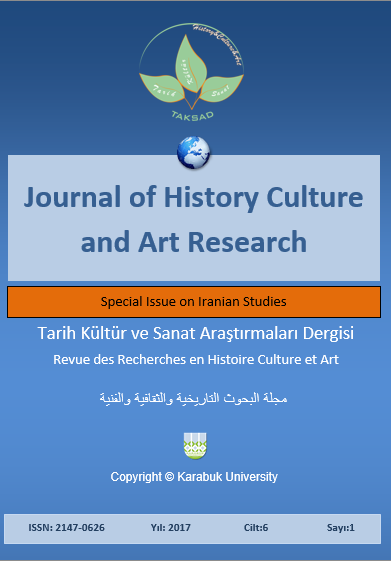An Integration between Baluch’s Costumes and Contemporary Iranian Woman: An Apparel on Aesthetics Elements
DOI:
https://doi.org/10.7596/taksad.v6i1.703Keywords:
Baluch, Traditional costume, Design, Fashion, Iranian women, Dressing.Abstract
This paper investigates costume fashion design of a specific Iranian group, specifically Baluch people. In this study, we have conducted a research to make an appropriated and functional association between modern daily fashion and Iranian local regional clothes as a social and cultural identity characteristic. There are some textile manufacturing industries in Iran, in which about 400,000 employees are working in different branches of production. Baluch’s history indicates that their traditional costume has been derived from Iranian fundamental designs. Baluch culture has long been settled in the East of Iran. Baluch people are among the few Iranian tribes who are committed to their local costumes. This study is a cross-sectional survey in which 100 volunteers filled out the 7-scale questionnaires throughout some social networks among Iranian adult women (Age: 30±0.5). We also gathered some information based on the literature review, observation and museums and exhibitions of handicrafts visits. In this study, we focused on Baluch ethnic costumes, and we studied some articles in this field to develop a practical method in observing and assessing the sample costumers. Our data analysis indicates that 32% of volunteers partially agree that they have tendencies to pick fashionable clothing, 34% of volunteers agree that they prefer to be unique, 33% of volunteers partially agree that the national identity is important when it comes to fashion, and 28% of them partially agree about the importance of local origin of fashion. These results also express that 36% of volunteers partially agree that the traditional Iranian costume is appealing to them, and 33% of them partially agree that traditional costumes are usable as contemporary clothing. Per foregoing features of Baluch costumes in aesthetic, social and cultural context, and obtained results and relevant statistical analysis, it seems that Baluch costumes aesthetical identity can be applied in contemporary Iranian women’s clothing, considering fashion principles. Last but not least, design process is based on questionnaire results and the traditional Baluch costume analysis. Our findings show that the importance of considering some criteria during design process, such as national identity, tendency to wear local and colorful costumes, applying traditional handcrafts and motifs on contemporary clothing, uniqueness and elegance. The presented design is recommended based on the deduced results of previous phases.References
Anvary, H. & Shoar, J. (1999). Rostam and Esfandiar Epic, Tehran: Drops.
Anvary, H. (1999). Speaks with Culture, Volume 1, Tehran: Statement.
Aristotle (2009). About the Art of Poetry. Translated by M. Sohail, Tehran: Wisdom Publications.
Aristotle (2009). Art of Poem, Translated by Soheil Muhsin Afnan, Tehran: Hekmat Publications.
Chomsky, Noam (1998). The Psychology of Language of Thought, Translated by Kourosh Safavi, Tehran: Agah Press.
Delacampagne, Christian (2003). A History of Philosophy in the Twentieth Century, Translated by Bagher Parham, Tehran: Agah press.
Gaarder, Jostein (2010). Sophie’s Sufi World: A Novel about the History of Philosophy, Translated by Hassan Kamshad, Tehran: Nilufar Publication.
Gholam Rezaei, M. (2002). The Style of Persian Poetry of Rudaki to Shamloo, Tehran: Heroes.
Hashemi, M. (1970). On the Side of the Medes Iran, Tehran: The Mirror of Knowledge.
Hazrat Hassan (2012). Historian and Historiography, Tehran: Institute of Contemporary History.
Khanlari, Zahra (1962). A Guide to Persian Literature, Tehran: Tehran University Printing.
Magee, Bryan (2007). The Great Philosophers: An Introduction to Western Philosophy, Translated by Ezatollah Folladvand, Tehran: Khwarizmi Press.
Munshi, Abu’l Ma’ali NasrAllah (1994). Panchatantra, the Correction M. Mino, Tehran: Sepehr Publication.
Parsinejad, Iraj (2009). Ehsan Tabari and Literary Criticism, Tehran: Talks.
Rhymy, M. (1990). The Tragedy of Power in the Shahnameh of Ferdowsi, Tehran: Lily.
Safa, Zabihullah (1994). History of Literature in Iran, Summary of Mohammad Torabi, Volume I, Tehran: Phoenix.
Secretary, N. (1994). Panchatantra, Correct Spiritual Mojtaba, Tehran: Sepehr.
Shmysa, S. (1994). General Stylistics, Tehran: Ferdows.
Tafazoli, A. (1997). Literary History of pre-Islamic Iran, Tehran: Statement.
Tanner, Michael (2008). Schopenhauer: Metaphysics and art, Translated by Akbar Masoom Beigi, Tehran: Agah Press.
Zarrinkoub, Abdul (1992). Poet without Lies Unveiled Poetry, Tehran: Scientific Publications.
Zarrinkoub, Abdul (1995). Literary Criticism, Tehran: Amir Kabir.
Downloads
Published
How to Cite
Issue
Section
License
All papers licensed under Creative Commons 4.0 CC-BY.- Share — copy and redistribute the material in any medium or format
- Adapt — remix, transform, and build upon the material for any purpose, even commercially.
Under the following terms:
Attribution — You must give appropriate credit, provide a link to the license, and indicate if changes were made. You may do so in any reasonable manner, but not in any way that suggests the licensor endorses you or your use.
- No additional restrictions — You may not apply legal terms or technological measures that legally restrict others from doing anything the license permits.







